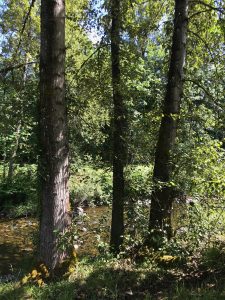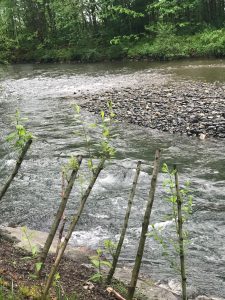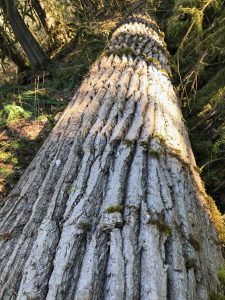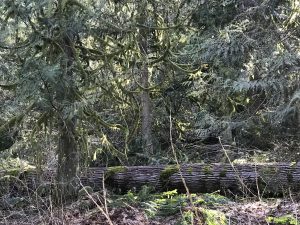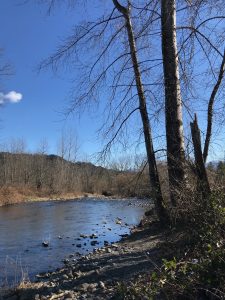 Cottonwood is my plant ally. She or “ki” has been my friend for many years. My friend Patti introduced me to Cottonwood’s magic. Years ago she gave me an oil infused with the resin of Cottonwood buds. I’ve been using it on my body and many other bodies in my massage therapy practice ever since. I find Cottonwood essence profoundly grounding and soothing. By essence I mean Ki’s resinous buds’ sweet balsamic scent, her towering tree body crowning toward the sky and her amazing rhizomes that spread from roots and fallen branches along rocky river beds.
Cottonwood is my plant ally. She or “ki” has been my friend for many years. My friend Patti introduced me to Cottonwood’s magic. Years ago she gave me an oil infused with the resin of Cottonwood buds. I’ve been using it on my body and many other bodies in my massage therapy practice ever since. I find Cottonwood essence profoundly grounding and soothing. By essence I mean Ki’s resinous buds’ sweet balsamic scent, her towering tree body crowning toward the sky and her amazing rhizomes that spread from roots and fallen branches along rocky river beds.
Ki is a a pronoun Robin Wall Kimmerer uses to refer to acknowledge “the being-ness of the tree.” She explains:
 . . . there’s a beautiful word — “bimaadiziaki,” which one of my elders kindly shared with me. It means “a living being of the earth.” But could we be inspired by that little sound at the end of that word, the “ki”? And use “ki” as a pronoun, a respectful pronoun inspired by this language as an alternative to “he,” “she,” or “it,” so that when I’m tapping my maples in the springtime, I can say, “We’re going to go hang the bucket on ki. Ki is giving us maple syrup this springtime.”
. . . there’s a beautiful word — “bimaadiziaki,” which one of my elders kindly shared with me. It means “a living being of the earth.” But could we be inspired by that little sound at the end of that word, the “ki”? And use “ki” as a pronoun, a respectful pronoun inspired by this language as an alternative to “he,” “she,” or “it,” so that when I’m tapping my maples in the springtime, I can say, “We’re going to go hang the bucket on ki. Ki is giving us maple syrup this springtime.”
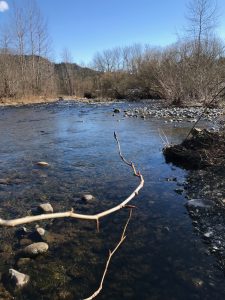 One Spring, Patti took me on a walkabout around the Three Forks Natural Area. We were looking for Cottonwood buds – Ki was going to give us her amber resin.
One Spring, Patti took me on a walkabout around the Three Forks Natural Area. We were looking for Cottonwood buds – Ki was going to give us her amber resin. 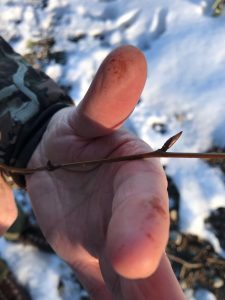 We plucked them off fallen and living branches staining our fingers sticky and breathing in the sweetness of our magical river friend. What better environment to find Cottonwood trees than at the confluence of the South, North and and Middle Forks of the Snoqualmie River? This riparian wonderland floods every year. The braided currents are always changing and the riverbank is always moving. Cottonwoods thrive under these conditions.
We plucked them off fallen and living branches staining our fingers sticky and breathing in the sweetness of our magical river friend. What better environment to find Cottonwood trees than at the confluence of the South, North and and Middle Forks of the Snoqualmie River? This riparian wonderland floods every year. The braided currents are always changing and the riverbank is always moving. Cottonwoods thrive under these conditions.
Tim and I moved to the Raging River nearly five years ago. Our house sits above the river and we share the land with three Cottonwoods, Maples and Douglas Fir trees. I think of the Cottonwoods as the three sisters that are keeping us safe by holding up the riverbank.
Every winter into late spring the Raging River rages with flooding waters cascading down Tiger Mountain. The force of the water carries whole trees down river and washes the sisters’ roots bare. 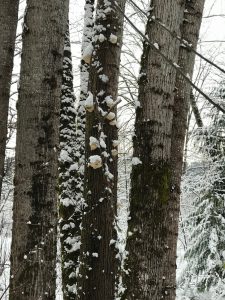 Tim and I have enjoyed watching them change with the seasons – in winter nearly naked except for the fungi, moss and lichens they host and the birds they carry.
Tim and I have enjoyed watching them change with the seasons – in winter nearly naked except for the fungi, moss and lichens they host and the birds they carry. 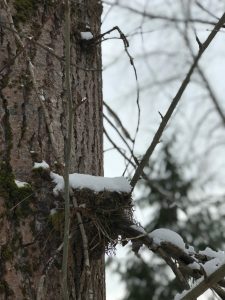
Buds begin to flower in chain-like catkins as early as February before leaves appear in April. The snowy seeds disperse about two months after flowering. 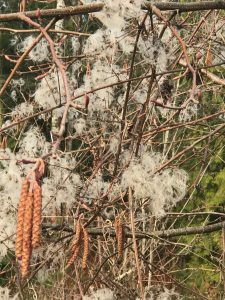 “Cotton” floats through the air carrying seeds and lands in little heaps on the ground or in the water.
“Cotton” floats through the air carrying seeds and lands in little heaps on the ground or in the water.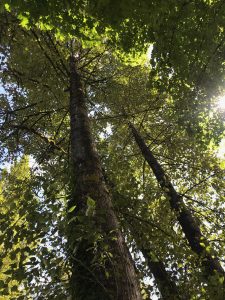
Leaves appear after flowering. The sisters’ crowns are filled with green heart shapes reflecting light and soaking in sunshine. The sisters’ presence feels as abiding as the earth. They draw me to the waters edge where I splash my face in early mornings.
The Earthwalk Northwest Ethnobotany Apprenticeship program began in February. Snow was on the ground and lay heavy on tree branches. I decided to deepen my relationship with Cottonwood through observation and study. Each week, J.T. our teaching assistant, helped us explore a mystery plant – touching, smelling, tasting various parts and sipping simple infusions – and by learning:
 Botanical name: Poplus balsamifera, P. trichocarpa, P. deltoides, P. fremontii, P. nigra
Botanical name: Poplus balsamifera, P. trichocarpa, P. deltoides, P. fremontii, P. nigra
Common name: Cottonwood, Black Cottonwood, Poplar
Family: Salicaceae (Willow)
Parts Used: Buds, Bark
Plant Properties: Antimicrobial, Anti-inflammatory, Antioxidant, Expectorant
Plant Uses: Pain, Infection, Fevers, Respiratory Issues, Preservative, Soil Remediation
Plant Preparations: Infused Oil, Salve, Tincture, Poultice, Decoction/Tea
J.T. and our instructor Karen described the ethnobotanical – traditional peoples’ – culinary, medicinal and practical uses of plants. They also discussed medical research studies and personal experiences of plant healing. Our class time seemed to just scratch the surface of the healing, nourishment and mystery plants so freely offer us.
 To learn more about Ki’s “botany” I consulted field guides and university publications including Plants of the Pacific Northwest and Hardwoods of the Pacific Northwest. These sources describe her home, structure, growth cycle and her virtues. Here is some of what I learned from Reinhard F. Stettler, professor emeritus of forestry at the University of Washington and author of “Cottonwood and the River of Time.”
To learn more about Ki’s “botany” I consulted field guides and university publications including Plants of the Pacific Northwest and Hardwoods of the Pacific Northwest. These sources describe her home, structure, growth cycle and her virtues. Here is some of what I learned from Reinhard F. Stettler, professor emeritus of forestry at the University of Washington and author of “Cottonwood and the River of Time.”
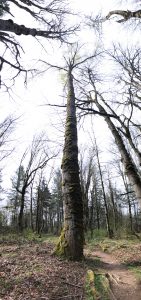 Cottonwood, a large deciduous tree, is one of the largest of some 40 species of Populus and is the tallest, fastest-growing hardwood in the western U.S. She is a well-known common tree along rivers and streams throughout the West.
Cottonwood, a large deciduous tree, is one of the largest of some 40 species of Populus and is the tallest, fastest-growing hardwood in the western U.S. She is a well-known common tree along rivers and streams throughout the West.
 Mature cottonwoods can reach heights of 125 to 150 feet and diameters of 48-60 inches. In her first 10 years she can grow around 5 feet annually!
Mature cottonwoods can reach heights of 125 to 150 feet and diameters of 48-60 inches. In her first 10 years she can grow around 5 feet annually!
She can mature as early as 60 years and live at least 200 years. We have the largest number of cottonwoods in Washington with about 60% in the Puget Sound subregion. Cottonwood doesn’t like shade. She strives to maintain a dominant position in the canopy through her amazing growth rates. She often towers over other emerging trees.
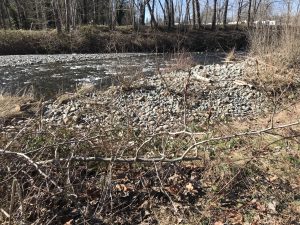 Cottonwood is a pioneer species. Pioneer plant species are the first predictable seeders, adaptable to many conditions and the most vigorous flora to colonize disturbed or damaged ecosystems. These plants readily acclimate to bare soil. They have the ability to grow, regenerate and respond vigorously on even the poorest soil sites and environmental conditions. She is specifically adapted to colonizing and dominating areas disturbed by floodwaters. Her growth is actually perpetuated by recurring floods!
Cottonwood is a pioneer species. Pioneer plant species are the first predictable seeders, adaptable to many conditions and the most vigorous flora to colonize disturbed or damaged ecosystems. These plants readily acclimate to bare soil. They have the ability to grow, regenerate and respond vigorously on even the poorest soil sites and environmental conditions. She is specifically adapted to colonizing and dominating areas disturbed by floodwaters. Her growth is actually perpetuated by recurring floods!
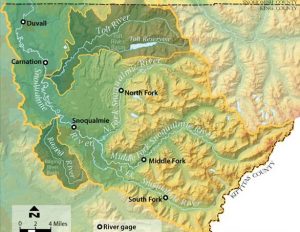 Here is a map of the Snoqualmie River’s forks coursing through the Valley. You can see where the North, Middle and South Forks converge not far above the great Falls. You can also see the confluence of the Tolt and Snoqualmie rivers in Carnation. These are wonderful sites to take in Cottonwood and also the river dynamics that are an integral part of her continuing adaptation and what Professor Stettler refers to as self hybridization.
Here is a map of the Snoqualmie River’s forks coursing through the Valley. You can see where the North, Middle and South Forks converge not far above the great Falls. You can also see the confluence of the Tolt and Snoqualmie rivers in Carnation. These are wonderful sites to take in Cottonwood and also the river dynamics that are an integral part of her continuing adaptation and what Professor Stettler refers to as self hybridization.
The Tolt Reservoir, water source for the City of Seattle, is also shown. If you look closely you will see the many “meanderings,” the river channels, made as flood waters push water downstream. In his book, Professor Stettler describes Cottonwood’s life cycle as it is in tune with the river’s dynamics and flooding cycles. The process of this pushing erodes the outside of a meander’s curve and creates what is called a “point bar” which forms habitat for Cottonwood and her neighbors.
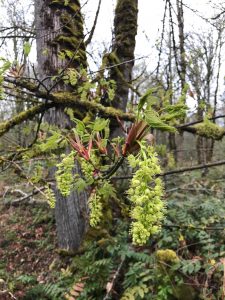 Neighbors are also in the willow family and are found along most major northwest rivers. These species include Pacific, River, Northwest and Scouler willows.
Neighbors are also in the willow family and are found along most major northwest rivers. These species include Pacific, River, Northwest and Scouler willows. 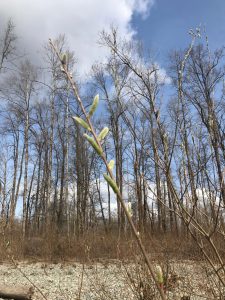 If you hike along any the river’s branches you will see her other friends including Red Alder, Oregon Ash, Big Leaf Maple, Douglas Fir, Western Red Cedar, Western Hemlock, Sitka Spruce, Grand Fir, Birch, Cherry and Hawthorn.
If you hike along any the river’s branches you will see her other friends including Red Alder, Oregon Ash, Big Leaf Maple, Douglas Fir, Western Red Cedar, Western Hemlock, Sitka Spruce, Grand Fir, Birch, Cherry and Hawthorn.
Common shrubs include Red Osier Dogwood, Vine Maple, Hazel, Salmonberry, Elderberry, Thimbleberry, Honeysuckle, Spirea and Snowberry. Other plants include Western Sword Fern, Ladyfern, Horsetail, Stinging Nettle, Hedge Nettle, False Solomon’s Seal, Violet Buttercup, Bittercress, Angelica, Golden Saxifrage and Bedstraw.
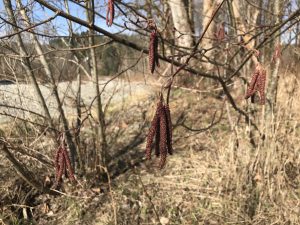 Cottonwood begins producing seeds at about 10 years of age. Male and female catkins (flowers) are borne on separates trees early March (or as late as mid-June in the north).
Cottonwood begins producing seeds at about 10 years of age. Male and female catkins (flowers) are borne on separates trees early March (or as late as mid-June in the north).
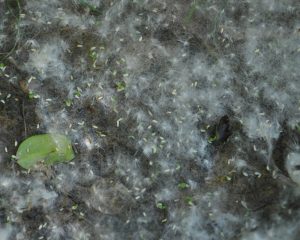 Female catkin seeds are inside capsulate-like fruits. Her abundant seeds are minute, tufted with cottony hair or fluff. They can fall and accumulate like snow. They can travel 20 miles on a breeze. The tiny seeds will float on water to a sandy beach and sprout within 24 hours of hitting even the rockiest shoreline.
Female catkin seeds are inside capsulate-like fruits. Her abundant seeds are minute, tufted with cottony hair or fluff. They can fall and accumulate like snow. They can travel 20 miles on a breeze. The tiny seeds will float on water to a sandy beach and sprout within 24 hours of hitting even the rockiest shoreline.
 Cottonwood magically regenerates by sprouting from stumps or buried fragments of branches. Here is a fallen branch I observed near the Tolt River. Even fallen leafy branches will root where they fall or where they are carried by water.
Cottonwood magically regenerates by sprouting from stumps or buried fragments of branches. Here is a fallen branch I observed near the Tolt River. Even fallen leafy branches will root where they fall or where they are carried by water.
The City of Seattle partnered with King County to restore the lower Tolt River by removing old levees and enhancing aquatic habitat conditions for the migrating Chinook salmon. Here you can see the way floodwaters have created another “meander” by pushing and eroding the riverbank. Look at one of the innovative ways Cottonwood segments are being used to shore up the banks after this years flood season.
When Cottonwood falls however, she is one of the least durable trees when resting on soil and exposed to the elements. She’ll start to decay with 1-2 weeks. Here is a fallen one I estimated to be over 100 feet tall. It was difficult for me to picture her majestic body in one photo.

This pool of water at her root base gave me a sense of her tremendous capacity for absorbing and then transpiring water.
 Fallen trees often provide structure for aquatic habitat in rivers and streams. Beaver remove many trees for dams and food. Elk and deer browse and rub their antlers on her.
Fallen trees often provide structure for aquatic habitat in rivers and streams. Beaver remove many trees for dams and food. Elk and deer browse and rub their antlers on her. 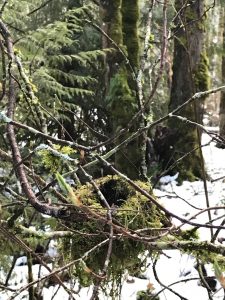 They also provide nesting and roosting perches for raptors.
They also provide nesting and roosting perches for raptors.
In Ethnobotany, we studied the uses and virtues of plants. I researched how native people interacted with Cottonwood. I found the text, Plants of the Pacific Northwest Coast, and the on-line Native American Ethnobotany Database to be very helpful. The Pacific Northwest tribes usage included:
Nuxalk/Kwakwaka’wakw/Halq’emeylem/Stl’stl’imx: Sweet inner bark and cambium tissues were eaten in late spring and early summer.
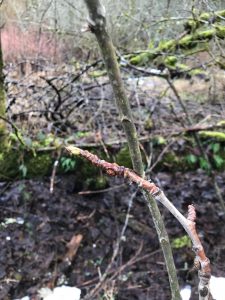 Hesquiat/Nuu-chah-nulth/Ditidaht: Buds boiled in deer fat to make a fragrant salve, which was molded into the bulbous float of bull kelp.
Hesquiat/Nuu-chah-nulth/Ditidaht: Buds boiled in deer fat to make a fragrant salve, which was molded into the bulbous float of bull kelp.
Nuxalk: Gum from the salve used in preparations for baldness, sore throats, whooping cough and tuberculosis. Buds used as a poultice for lung pains and rheumatism. Old leaves were boiled and used in a bath for body pains, rheumatism and stomach trouble. Stl’atl’imx/Tahltan: Wood used as fuel for smoking fish.
Coast Salish: Bruised leaves placed on cuts, bark infusion for sore throats.
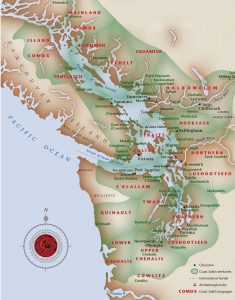 Quinault: Placed gums that exudes from burls of cottonwood directly on cuts and wounds, took a bark infusion for tuberculosis.
Quinault: Placed gums that exudes from burls of cottonwood directly on cuts and wounds, took a bark infusion for tuberculosis.
Ditidaht: Inner bark used to reinforce other plant fibers in spinning.
Vancouver Island Salish: Made small dugout canoes from black cottonwood. Aromatic gum from spring buds used to waterproof baskets and boxes.
Okanagan/Upper Halq’emeylem/Cowlitz: Friction fire sets made using dried cottonwood roots for the hearth and dried branches for the drill.
Okanagan: Soap and hair wash made using ashes from cottonwood.
Coast Salish/Okanagan/Stl’atl’imx: Bark stripped off and used to make buckets for carrying and storing food. Young shoots used to make sweat lodge frames. Nisga’a/Quinault:  Temporary cabins constructed using cottonwood bark, roots twisted into rope for tying house planks and making fish traps.
Temporary cabins constructed using cottonwood bark, roots twisted into rope for tying house planks and making fish traps.
Okanagan/Stl’atl’imx: Gum from spring buds used as a glue for securing arrowheads and feathers to shafts.
Okanagan/Ditidaht: Gum from buds boiled in grease and mixed with other pigments (alder bark, larch, wolf lichen, charcoal) to make paint.
 How wonderful the first peoples’ tradition of salve making is still alive and well today. Cottonwood continues to work her healing magic in our lives. Our Ethnobotany Apprenticeship group learned quite a few medicinal applications of wild plants including infused oils, simple salves, creams and lotions. Earlier in the course we were tromping through the snow and working outside. The the skin on my hands started cracking so I decided to experiment by making a Forager’s Finger Butter with infused oils of Cottonwood and Devil’s Club. I hope my friends will be happy with the results.
How wonderful the first peoples’ tradition of salve making is still alive and well today. Cottonwood continues to work her healing magic in our lives. Our Ethnobotany Apprenticeship group learned quite a few medicinal applications of wild plants including infused oils, simple salves, creams and lotions. Earlier in the course we were tromping through the snow and working outside. The the skin on my hands started cracking so I decided to experiment by making a Forager’s Finger Butter with infused oils of Cottonwood and Devil’s Club. I hope my friends will be happy with the results.
Contemporary studies of Cottonwood include those for arthritis, skin conditions and cancer. There have also been a number of studies using Cottonwood to clean contaminated soil. 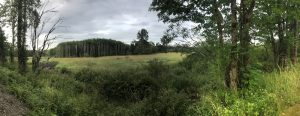 Cottonwood is also cultivated in plantations for the production of pulp, paper and plywood. In 2014 Oregon State University received a $1 million grant from the U.S. Department of Agriculture for a study that could help increase the productivity of trees used for bioenergy. In 2016 OSU won a $4 million, five-year grant from the National Science Foundation to continue their research along with other educational programs. Poplar hybrids may provide a new source of cellulosic biofuel and show promise in the cleanup of industrial pollution sites. Cottonwood is the first tree species to have its complete genome sequenced.
Cottonwood is also cultivated in plantations for the production of pulp, paper and plywood. In 2014 Oregon State University received a $1 million grant from the U.S. Department of Agriculture for a study that could help increase the productivity of trees used for bioenergy. In 2016 OSU won a $4 million, five-year grant from the National Science Foundation to continue their research along with other educational programs. Poplar hybrids may provide a new source of cellulosic biofuel and show promise in the cleanup of industrial pollution sites. Cottonwood is the first tree species to have its complete genome sequenced.
Cottonwood, A River in Time, reveals a broader, all encompassing view of uses and virtues – one that includes all our relations. Professor Stettler describes a very old cottonwood, a matriarch, as:
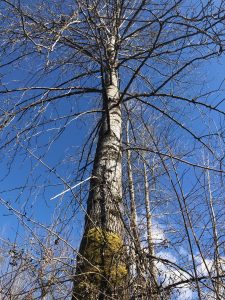 an ecosystem in itself. Its huge biomass has miles of roots in the ground, drawing water and nutrients from deep horizons and transporting them to the youngest twigs at great heights; it builds up the soil, is host to symbionts and epiphytes, offers roosting and nesting sites to birds, feeds countless species of invertebrates, and creates a unique microclimate for all the organisms around it. . . .
an ecosystem in itself. Its huge biomass has miles of roots in the ground, drawing water and nutrients from deep horizons and transporting them to the youngest twigs at great heights; it builds up the soil, is host to symbionts and epiphytes, offers roosting and nesting sites to birds, feeds countless species of invertebrates, and creates a unique microclimate for all the organisms around it. . . .
He reminds us that:
What drives our plant are processes, and the products are incidental and temporary. . . . Process is what deserves our attention if we want to understand how what we find 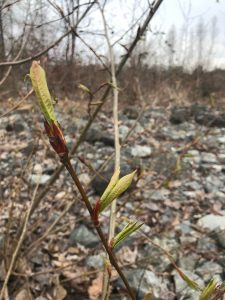 in nature has come about, and how it is likely to function and change. True, a process needs something to work on, or work with. Erosion can only take place on something erodible. Evolution will only manifest itself in something evolvable, a string of DNA, a beak on a finch, a leaf on a cottonwood. So in the end we need the products, the structures by which to study the processes.
in nature has come about, and how it is likely to function and change. True, a process needs something to work on, or work with. Erosion can only take place on something erodible. Evolution will only manifest itself in something evolvable, a string of DNA, a beak on a finch, a leaf on a cottonwood. So in the end we need the products, the structures by which to study the processes.
No words are needed to express this sense of continuous change and connection when I walk the riverbanks along the Raging, Snoqualmie and Tolt Rivers. It’s been a wonderful experience to live with Cottonwood and witness her changes in winter, spring and our glimmering summer. I am deeply grateful for the encouragement and guidance I’ve received from my Earthwalk Northwest teachers: Karen and J.T. They truly share the love, magic and wonder.

